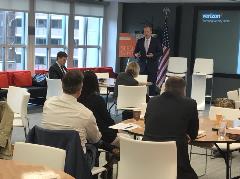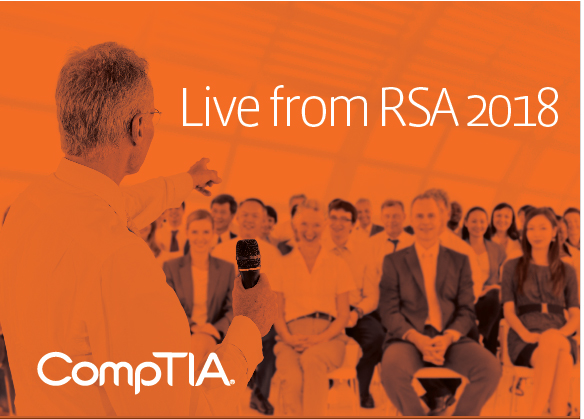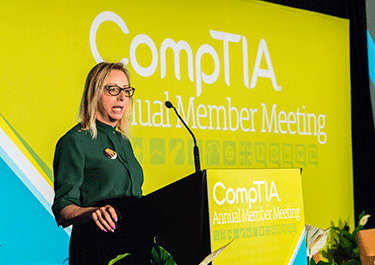 Last week, the CompTIA State & Local Government and Education (SLED) Council hosted its first SLED Summit of the year at the Verizon Tech & Policy Center in Washington DC. We heard from government and public sector leaders, the federal government and other local leaders who dove into issues relevant to our SLED Council membership. One of our speakers was Charles Cooper, executive vice president of the Signal Group who provided a federal tech policy government outlook with a deep dive into the current administration and how federal policies will affect policy and tech spending at the state/local level.
Last week, the CompTIA State & Local Government and Education (SLED) Council hosted its first SLED Summit of the year at the Verizon Tech & Policy Center in Washington DC. We heard from government and public sector leaders, the federal government and other local leaders who dove into issues relevant to our SLED Council membership. One of our speakers was Charles Cooper, executive vice president of the Signal Group who provided a federal tech policy government outlook with a deep dive into the current administration and how federal policies will affect policy and tech spending at the state/local level.
Cooper began his presentation discussing the 2018 midterm elections and what the landscape looks like – specifically, an environment where bipartisanship is endangered but not extinct and a congressional divide with Republicans in the majority. “Americans will head to the polls on November 6 to elect members for each of the 435 House seats and 34 of the 100 Senate seats. Republicans are hoping to maintain their majority in both houses, and Democrats are facing an uphill battle this year in both chambers of Congress. On the House side, Democrats need 24 seats to flip the House and on the Senate side, Democrats need two seats to take the Senate.”
Some of the policy trends we are seeing in 2018 include federal funding levels higher than expected. “We are also seeing increased policy pressure on the tech industry because of front page news stories and social media posts on issues like data breaches. The result, more policymakers are focused on technology policy than ever before.”
On the trade front, Cooper said there are several activities taking place including the 301 investigation into China intellectual property practices. “We are seeing proposed tariffs on certain imports from China including products in aerospace, information and communication technology and machinery – roughly $60 billion in Chinese imports.” In addition, NAFTA negotiations between the U.S. Canada and Mexico are potentially nearing an agreement. “NAFTA won’t be as daunting as people expect,” Cooper said.
Education and workforce policy and funding has increased and we’re seeing movement in Congress on apprenticeships, education and job training including the CHANCE in Tech Act (H.R. 3174) which will help provide workers from all backgrounds with the skills and knowledge they need to fill good-paying tech jobs. “This legislation will better align workforce training in the IT industry to better meet local and regional workforce demands. In 2017, CompTIA got CHANCE in Tech introduced; in 2018, they would like to get it passed into law.”
On the immigration policy front, immigration laws need to be modernized to help facilitate near-term investments in the technology workforce. At this point, U.S. Citizenship and Immigration Services (USCIS) reached the 65,000 cap for H-1B high skilled work visa applications and reached the 20,000 visa cap for those with U.S. advanced degrees after five days (6th year in a row). “The Supreme Court has ruled on two immigration provisions; turning policy decisions back to Congress-- immigration issue won’t be resolved in this Congress. And really, there is no single solution to filling the workforce, it’s not just about H-1B,” Cooper said.
On the cyber and IT policy front, federal funding has increased steadily. We also saw the Department of Homeland Security Authorization Act of 2017 pass the House and now we’re awaiting action in the Senate.
Smart cities and smart city projects which are made possible by a purposeful and integrated Internet of Things (IoT) is receiving a lot of support from Congress, Cooper said. He discussed the Smart Cities and Communities Act of 2017 which would set aside $220 million per year to replace outdated infrastructure with smart technologies like connected roadway infrastructure, environmental sensors, and data analytics. He also discussed the Smart Technology for Resilient, Efficient, Economic and Reliable Transportation in Cities and Communities Act (STREET Act) which expands on the successful Department of Transportation (DOT) Smart Cities Challenge program and will provide grants to small and medium sized cities on a competitive basis.
Currently, there’s a lot of discussion right now in Congress on how to regulate IoT. Should there be NIST voluntary standards on IoT v. legislation? “It’s being debated, and it is a challenge of the future,” Cooper added.
A very interesting outlook at tech policy and spending at the federal level!
Lana Sansur is CompTIA’s senior marketing manager of policy and public sector




0